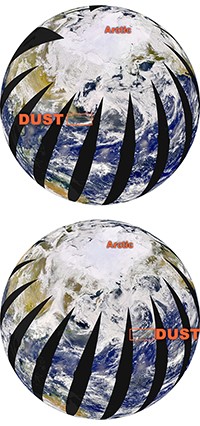Atmospher Sci & Global Chg
Research Highlights
April 2017
Gone with the Wind: Trans-Pacific Journey of Atmospheric Particles
Observations and models reveal the fate of tiny dust particles carried in the atmosphere

Regular dust storms are sometimes powerful enough to reach across the Pacific Ocean and dim skies over North America. This 2005 Sea-viewing Wide Field-of-view Sensor from the NASA OrbView-2 satellite detected a large dust storm over China. From April 29 until May 5, the satellite tracked the dust storm over the Pacific Ocean. Now PNNL researchers show that large dust particles can travel further than previously believed-and affect communities far from the source. Images courtesy of NASA Visible Earth: SeaWiFS images courtesy the SeaWiFS Project, NASA/Goddard Space Flight Center, and ORBIMAGE.
Puzzling skiers, occasional brownish-yellow plumes waft over Colorado ski resorts during winter and spring. Instead of wondering, researchers led by scientists at Pacific Northwest National Laboratory decided to get to the bottom of the plumes' source and content. Their research, now published in the Journal of Atmospheric Sciences found that the plumes hold countless dust particles carried from remote desert areas in Asia and Africa-dust from thousands of miles away travels to the western United States by high-altitude winds over the Pacific Ocean. The researchers also found that the atmospheric lifetime of the larger-sized dust particles is longer than expected. Climate models had always assumed the largest particles would fall out and not be transported such long distances.
Why It Matters: Many atmospheric processes, such as long-range transport of particles and their removal from the atmosphere by rain and snow, largely depend on the size of the particle. Just by their size, large particles are seemingly more susceptible to this removal than smaller ones. Climate models use a simplified representation of these complex and size-dependent processes for efficiency's sake. In particular, climate model's predict that the dust particles with large sizes may remain suspended in the atmosphere only over relatively short distances, traveling only hundreds of miles away from their origin.
This study provides new insight into the evolution of large dust particles during their trans-Pacific voyage from Asia and Africa. The surprising conclusion is that these particles may remain suspended in the atmosphere much longer and travel for remarkably larger distances-thousands rather than hundreds of miles as the models predict. The results provide important data for scientists to fine-tune the models with the most recent understanding of atmospheric transport.
Methods: PNNL researchers teamed with collaborators from the University of Nevada, University of Wisconsin, Desert Research Institute, and National Oceanic and Atmospheric Administration to identify and characterize a major dust event at the high-elevation research sites in Colorado using an integrated, ground-based dataset of aerosol properties and sophisticated high-resolution simulations of dust evolution using a chemical transport model.
The researchers complemented their dust event characterization by analyzing the corresponding low-resolution simulations from a climate model, satellite observations, and additional ground-based measurements in Asia and the western United States. The team compared their high- and low-resolution simulations to demonstrate a better match for both the ground-based and satellite data.
What's Next? The new modeling framework-with strongly linked observational and modeling components-has the potential to estimate uncertainties of climate model predictions associated with transport-related processes. The team plans to apply this framework to various climate-important regions wherever integrated, ground-based aerosol property datasets are available.
Acknowledgments
Sponsors: This research was supported by the U.S. Department of Energy Office of Science, Biological and Environmental Research as part of the Atmospheric Radiation Measurement (ARM) Climate Research Facility, Atmospheric System Research (ASR), Earth System Modeling (ESM), and Regional and Global Climate Modeling (RGCM) Programs. The StormVEx campaign was supported by the ARM and ASR programs.
Research Team: Evgueni Kassianov, Mikhail Pekour, Connor Flynn, Larry Berg, J Beranek, Alla Zelenyuk, Chun Zhao, L. Ruby Leung, Po-Lun Ma, Laura Riihimaki, Jerome Fast, and Phil Rasch, PNNL; J. Barnard, University of Nevada-Reno; A Gannet Hallar and Ian B McCubbin, Desert Research Institute-Colorado; Edwin W Eloranta, University of Wisconsin-Madison; and Allison McComiskey, NOAA Earth System Research Laboratory.
User Facility: ARM Climate Research Facility
Research Areas: Climate and Earth Systems Science; Physical Sciences
Reference: Kassianov E, M Pekour, C Flynn, LK Berg, J Beranek, A Zelenyuk, C Zhao, LR Leung, PL Ma, L Riihimaki, JD Fast, J Barnard, AG Hallar, IB McCubbin, EW Eloranta, A McComiskey, PJ Rasch. 2017. "Large Contribution of Coarse Mode to Aerosol Microphysical and Optical Properties: Evidence from Ground-based Observations of a Trans-Pacific Dust Outbreak at a High-Elevation North American Site." Journal of the Atmospheric Sciences. DOI: 10.1175/JAS-D-16-0256.1
Related highlights: Invisible Giants in the Sky
